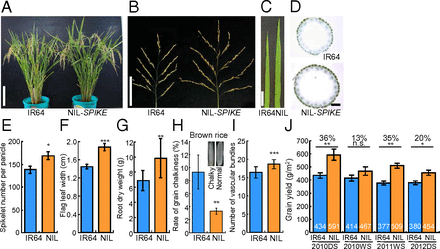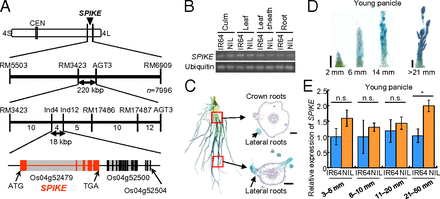一个地方水稻品种的NAL1等位基因大大增加现代籼稻品种产量
来源:《PNAS》
作者:Daisuke Fujita等
时间:2014-01-06


意义 本工作报告一个农业水稻重要基因的发现。印尼水稻地方品种的一个称为小穗数目(SPIKE)基因的鉴定,可以显著增强现代栽培稻产量。SPIKE基因增加在热带地区广泛种植籼稻品种IR64的四季田间谷粒产量,而不需要改变谷粒品质或发育期即可改善植株结构,这对区域适应性非常重要。这些结果表明,SPIKE基因的发现对增加籼稻品种的粮食生产具有非常重要的价值。
随着经济和人口的增长,提高作物产量是未来亚非发展中国家粮食供应的基本保障。尽管20世纪60年代绿色革命增加了粮食产量,然而,自此之后,在水稻增产潜力方面再也没有取得任何重大进展。
在这项研究中,作者从热带粳稻地方品种发现了一种基因,小穗数目(SPIKE)基因,通过对株型产生多向性作用而提高籼稻品种的谷粒生产能力。图谱克隆表明SPIKE等同于NARROW LEAF1 (NAL1)基因,已报道其控制叶脉模式。一个通用籼稻品种近等基因系IR64和超表达系的表型分析揭示穗粒数、叶面积、根系统和维管束数目都产生了增加,表明源大小、迁移能力以及库大小的增强。近等基因系增产13–36%,而对外观没有任何负面影响。表达分析表明,该基因在所有类型的细胞中都表达:穗、叶、根和茎,证明对植物结构的多向性影响。此外,SPIKE增加最近发布的籼稻品种IRRI146的谷粒产量达18%,也增加其他通用籼稻品种遗传背景的小穗数。水稻育种中SPIKE基因的利用将有助于南亚、东南亚等籼稻种植地区的粮食保障。(编译:中国科学院成都生物研究所 王芋华,王海燕)
NAL1 allele from a rice landrace greatly increases yield
in modern indica cultivars
Abstract Increasing crop production is essential for securing the future food supply in developing countries in Asia and Africa as economies and populations grow. However, although the Green Revolution led to increased grain production in the 1960s, no major advances have been made in increasing yield potential in rice since then. In this study, we identified a gene, SPIKELET NUMBER (SPIKE), from a tropical japonica rice landrace that enhances the grain productivity of indica cultivars through pleiotropic effects on plant architecture. Map-based cloning revealed that SPIKE was identical to NARROW LEAF1 (NAL1), which has been reported to control vein pattern in leaf. Phenotypic analyses of a near-isogenic line of a popular indica cultivar, IR64, and overexpressor lines revealed increases in spikelet number, leaf size, root system, and the number of vascular bundles, indicating the enhancement of source size and translocation capacity as well as sink size. The near-isogenic line achieved 13–36% yield increase without any negative effect on grain appearance. Expression analysis revealed that the gene was expressed in all cell types: panicles, leaves, roots, and culms supporting the pleiotropic effects on plant architecture. Furthermore, SPIKE increased grain yield by 18% in the recently released indica cultivar IRRI146, and increased spikelet number in the genetic background of other popular indica cultivars. The use of SPIKE in rice breeding could contribute to food security in indica-growing regions such as South and Southeast Asia.
原文链接:http://www.pnas.org/content/110/51/20431.full




